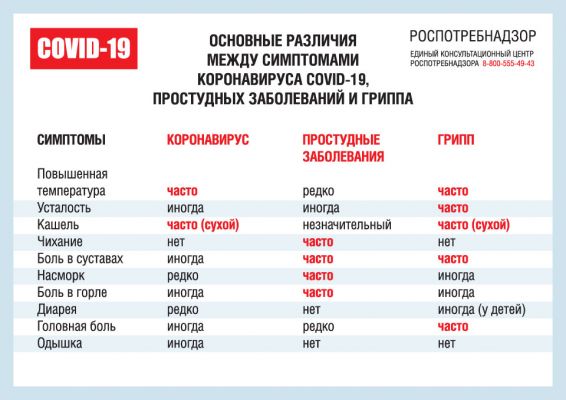Rospotrebnadzor released today, October 29, a message explaining the main differences between the symptoms of the Covid-19 coronavirus from colds and flu.
How are Covid-19 and influenza viruses similar?
Covid-19 and influenza viruses have a similar disease pattern. They both cause respiratory illness, which is a wide range of disease variants, from asymptomatic or mild to severe illness and death.
Both viruses are transmitted by contact, by airborne droplets and through fomites. Therefore, do not forget about the simple rules of prevention: use a mask, observe hand hygiene and social distance.
How do Covid-19 and influenza viruses differ?
An important difference between the two viruses is transmission speed.
Influenza has a shorter average incubation period (time from infection to symptom onset) and a shorter serial interval (time between successive cases) than Covid-19 virus. The serial interval for the Covid-19 virus is estimated at 5-6 days, while for the influenza virus, the consecutive interval is 3 days. This means the flu can spread faster than Covid-19.
In addition, transmission in the first 3-5 days of illness, or potentially presymptomatic transmission – transmission of the virus before symptoms appear – is the main cause of influenza transmission. In contrast, it is known that there are people who can spread the Covid-19 virus 24-48 hours before symptoms appear, which currently does not appear to be the main cause of transmission.
The reproductive rate – the number of secondary infections caused by one infected person – is estimated to be between 2 and 2.5 for the Covid-19 virus, higher than for influenza. However, estimates made for Covid-19 and influenza are highly contextual and time-dependent, making direct comparisons difficult.
“The two viruses have a similar spectrum of symptoms, with the proportion of severe cases likely to differ. For Covid-19, data to date suggest that 80% of infections are mild or asymptomatic, 15% are severe, requiring oxygenation, and 5% are critical, requiring ventilation. The proportion of severe and critical cases is higher than those observed for influenza, ”Rospotrebnadzor notes.
Children, pregnant women, the elderly, and people with chronic illnesses and immunodeficiencies are most at risk of severe influenza infection. With regard to Covid-19, older age and underlying medical conditions are known to increase the risk of severe infection.
The information was prepared on the basis of WHO materials, the department said.
–


